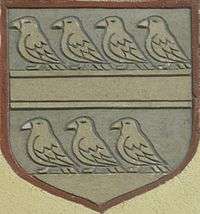Drugeth family
| House of Drugeth | |
|---|---|
 | |
| Country | Kingdom of Hungary |
| Titles |
|
| Founded | c. 1315 |
| Founder | Fülöp (Philip), Palatine of Hungary |
| Final ruler | Zsigmond II (executed) |
| Dissolution | 1684 |
The Drugeths were a noble family (of French origin) of the Kingdom of Hungary in the 14-17th centuries whose possessions were situated on the north-eastern parts of the kingdom. The ancestors of the family left Apulia (Italy) for Hungary during the reign of King Charles I. Several members of the family held high offices in the first half of the 14th century and later, when the Drugeth estates were the largest in all of Hungary.[1] The family continued to be important until the male line died out in 1691.
Notable members of the family
The first member of the family establishing himself in the Kingdom of Hungary was Philip Druget (Hungarian: Druget Fülöp) (cca. 1288-1327) who accompanied the future King Charles I from the Kingdom of Naples to Hungary in 1300. He took part in the king's military campaigns against his opponents and the rebelling aristocrats. He led the king's armies, in 1317, against the rebellious Peter, son of Petenye (who possessed several castles in Zemplén county) and in 1320, against Matthew III Csák. He was the head (ispán) of the Counties Szepes (1315–1327), Abaúj (1317–1327), Gömör and Torna (1320–1327). Philipp was the Master of the Queen's Treasury (királynéi tárnokmester) between 1321 and 1327, when King Charles appointed him to Palatine (nádor); he hold the latter office until his death. King Charles granted him the possession of the Castles Barkó (Slovak: Brekov), Jeszenő (Slovak: Jasenov), Lubló (Slovak: Ľubovňa), Palocsa (Slovak: Plaveč), Szokoly (Slovak: Sokoľ) and Terebes (Slovak: Trebišov).

Philip's brother, John Drugeth (Hungarian: Druget János) (?-1334) arrived from the Kingdom of Naples to Hungary before Philip's death. King Charles I appointed him to Palatine in 1328. He was also the head of the Counties Bács (1330–1333), Fejér, Somogy, Tolna, Ung and Zemplén (1328–1333) and castellan of Óbuda (1328). The king granted him the Nevicke Castle in 1332. In 1333, he returned to Naples.
Palatine John's elder son, William Drugeth (Hungarian: Druget Vilmos) (?-1342) was the most powerful member of the family. He followed his uncle, Philip in his offices in 1327, and became the head of the Counties Abaúj, Gömör and Szepes, (1327–1342); and he also was the ispán of the Counties Borsod, Heves (1327–1342) and Sáros (1328–1342). He inherited his uncle's possessions on the north-eastern parts of the kingdom where he had the Dunajec Castle built before 1333. Around 1330, he acquired the Castle of Szalánc (Slovak: Slanec). When his father left for Naples in 1333, William became his deputy as Palatine, and followed him as the head of the Counties Ung and Zemplén (1333–1342). Following his father's death in 1334, William was appointed to Palatine. In 1340, he led the armies King Charles I sent to Poland in order to assist King Casimir III of Poland. In his last will, he left his possessions to his brother, Nicholas, but King Louis I of Hungary confiscated them upon the request of his mother, the Queen Dowager Elisabeth.
Palatine John's second son, Nicholas Drugeth de Gergény (Hungarian: gergényi Druget Miklós) (?-1355) was appointed to Master of the Cup-bearers (pohárnokmester) in 1332 and he became the head of Ugocsa County in 1337. When his brother, William died in 1342, King Louis I not only confiscated him of the inheritance, but also removed Nicholas from his offices. However, he regained the king's favor soon who granted Barkó and Nevicke jointly to Nicholas and his brother, John from William's legacy in 1343. In the same year, Nicholas became the head of the Ung County (1343–1354). Nicholas was appointed judge royal (országbíró) (and he became also the ispán of Turóc County) in 1354, and thus held the third office of the kingdom in his last year. The branch "Gerényi" of the Drugeth family ascended from him, but its male line died out already in the third generation.
Palatine John's third son, John Drugeth de Homonna (Hungarian: homonnai Druget János) (?-1361) founded the "Homonnai" branch of the family - today the town of Humenne in Slovakia. In 1343, he was granted the possession of Barkó and Nevicke jointly with his younger brother, Nicholas. John followed Nicholas as head of the Ung County (1354–1362).
Sources
- General
- Markó, László: A magyar állam főméltóságai Szent Istvántól napjainkig - Életrajzi Lexikon (The High Officers of the Hungarian State from Saint Stephen to the Present Days - A Biographical Encyclopedia); Magyar Könyvklub, 2000, Budapest; ISBN 963-547-085-1.
- Engel, Pál: Magyarország világi archontológiája (1301–1457); História - MTA Történettudományi Intézete, 1996, Budapest; ISBN 963-8312-43-2.
- Lenčiš, Štefan: Šľachtický rod Drugetovcov z Humenného; 181 p.; Humenné - Miestny Odbor Matice Slovenskej, 2003, Humenné; ISBN 809-6730-25-8, ISBN 978-8096-730-25-4.
- Inline
- ↑ Paul Robert Magocsi, Ivan Pop. Encyclopaedia of Rusyn History and Culture. University of Toronto Press, 2002. ISBN 0-8020-3566-3. Page 99.
External links
- Marek, Miroslav. "Family tree of the Drugeth family". Genealogy.EU.
.svg.png)